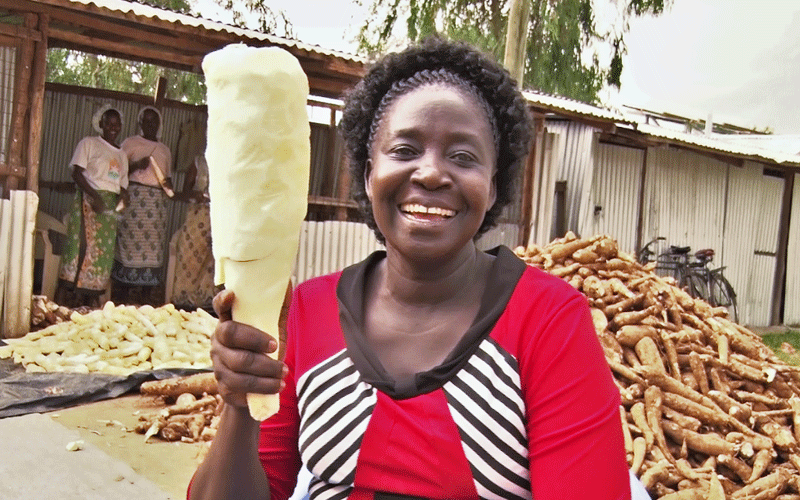New disease-resistant cassava variety offers hope to farmers

Maize farming has become a source of major frustrations for Grace Sua. Despite her best efforts, persistent drought has seen her yields wither and her two-acre farm produce less and less each harvest.
Seated under the drought resistant local Mututi tree in her family homestead tucked inside rural Mutomo village in Kitui county, Sua is in state of mourning for only relying on maize farming to feed her six children.
“I exchanged my two cows for maize seeds, which I planted when rains pounded towards the end of last year. Now I don’t know what to do if the current drought persists,” she says.
Wilting maize stalks characterise her almost bare piece of land, which only a month ago she had expected would produce a bumper harvest.
Her neighbour Daniel Ntheuu, just a few metres from her farm has been cushioned against food insecurity by growing cassava.
“I learnt a bitter lesson in the past when I relied on farming maize alone. Cassava doesn’t dry up in case of drought,” says Ntheeu.
“There has been a perception that ‘food is maize’. This has threatened food security with farmers trying to grow maize in poor soils with low precipitation, which cannot support the crop to maturity,” says Flora Nzambuli, a community mobiliser, who serves as a role model of how women can influence measures to be taken at the local level to ensure there is sufficient food by encouraging farmers to grow cassava in the area.
The plant grows up to 15 feet tall and is a food staple for about 500 million people worldwide. 
There have been efforts to add value to the cassava, whose edible parts are the tuberous roots and leaves by producing bread, crisps, chapatis, vegetables, flour, but the tragedy has been massive loss of the tuber crop because of the deadly Cassava Brown streak Disease (CBSD).
Disease resistant
University of Nairobi don and Kenya’s principal cassava investigator Prof Douglas Miano also names Cassava Mosaic Disease (CMD) as another second dangerous disease, previously thought to be tamed.
Researcher Dr Simon Gichuki says over 250 million people in sub-saharan Africa rely on cassava as their major source of calories from the crops directly consumed by human and ranked fifth in the world.
Dr Gichuki says cassava is the basic food of over 600 million people in the world, but regrets combined annual economic loss of up to Sh19.1 billion in East Africa.
Director general of Kenya Agricultural and Livestock Research Organisation (Kalro), Dr Eliud Kireger says besides diseases, lengthy growing cycle results in slow breeding.
Production of the Genetically Modified(GM) cassava, he says, holds the key to production in a continent faced with the challenge of aging farmers, labour intensive traditional production techniques and a youthful population with farming phobia.
“Biotechnology offers a science that is less labour intensive in terms of innovation, climate smart innovations modern disease, pests, weeds, drought diagnostics, forecasting and control innovations. This is biotech,” says Dr Krieger.
Prof Miano is the brain behind the research of the variety under the Resistant Cassava for Africa (VIRCA-Plus) Project, with field trials being held in various locations across the country.
The project was aimed at developing virus diseases resistant cassava with improved nutrition.
“Though an important food security crop, yields have been low due to viral diseases and the crop lacked most essential nutrients,” says Prof Miano of the variety whose research has been carried out since 2016 alongside Kalro biotechnology centre director, Dr Catharine Taracha.
Field trials have been taking place under the Virus Resistant Cassava for Africa (VIRCA-Plus) Project in various locations across the country with the approval and supervision of the NBA, enabling researchers to select improved varieties that meet farmers’ needs, while assuring health and environmental safety of GM cassava.
“Kalro using Biotechnology approaches sought to address disease and nutrition constraints, besides poor post harvest shelf life, high cyanide levels in some varieties and low yield,” says Dr Krieger.
Experts in biotechnology hail the variety as a crucial tool to improve food security and boost President Uhuru Kenyatta’s food and nutrition agenda.
In Kenya cassava is grown in over 90,000 hactares with an annual production of about 540,000 tonnes.
However, despite its great potential as a food security and income generation crop among rural poor in marginal lands, its utilisation remains low in Kenya.
The variety is not only resistant to common cassava diseases, but it has high nutritional value, according to the director, International Service for the Acquisition of Agri-biotech Applications, Dr Margret Karembu.



